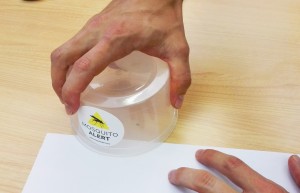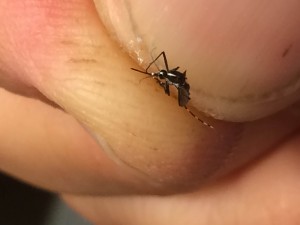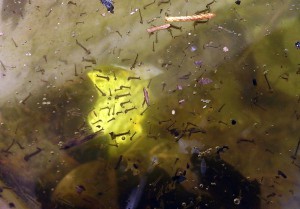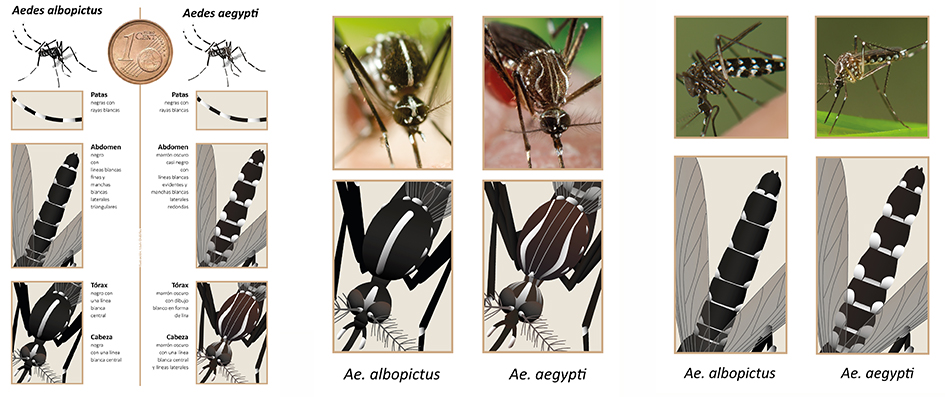Project and objectives
Citizen science refers to activities involving the general public in scientific research. Citizens can contribute resources and valuable information, share knowledge, help collect and analyze data, interpret results, make new discoveries, develop technologies and applications, or solve complex problems.
See these links for more information:
Thanks to citizen participation in the project, the arrival of the tiger mosquito to the Spanish Autonomous Communities of Andalucía and Aragon as well as a number of other cities and provinces was confirmed for the first time. Early detection of the urban Aedes is very important, particularly for planning and application of responses and different control measures.
Since 2014, citizen sightings of possible tiger mosquitos were made in more than 360 Spanish cities. This information helped confirm the extended presence of the tiger mosquito in coastal and southern cities of Catalonia, the Community of Valencia, the Region of Murcia, the Balearic Islands, and Andalucía. The sightings have also revealed that the mosquito is moving northeastward on the island of Majorca, and from the eastern and southern parts of Spain towards the interior. You can find more project information and results in the 2015 Annual Report.
Beginning in 2015, citizen sightings via Mosquito Alert have become an additional source of information used for control measures in different areas of Spain. In 2015, 20% of citizen sightings in Barcelona sent by Mosquito Alert were considered useful by the Barcelona Public Health Agency and integrated into its monitoring and control program. Also, in the city of Valencia 40% of new risk areas were detected thanks to citizen sightings sent with the Mosquito Alert app.
In all countries and governments, responsibilities for public health and invasive species are separated into distinct agencies and administrations. This project is led by research centers whose primary purpose is to conduct research. For this reason, we do not engage directly in monitoring or control programs.
However, we do collaborate with administrations such as the Barcelona Public Health Agency (ASPB) in topics related to control of disease vectors. Data sent by citizens via Mosquito Alert are very valuable to public entities working to control and monitor these insects. In Spain there are many professionals working on the control of the tiger mosquito in places like Valencia, Barcelona, el Baix Llobregat, or Girona. There are even public service units whose only mission is to monitor and control these mosquitos.
The tiger mosquito is not like other mosquito species that breed in wetlands; instead, this mosquito hides in and lays eggs in small containers. A large portion of these kinds of mosquito-friendly objects are often found on private property, making them difficult to detect in order to deal with the problem. The best way to fight proliferation of this mosquito is through prevention. Along these lines, Mosquito Alert is an important tool for raising awareness about the application of control measures in the home and on private property.
Your data contributions will be incorporated into a database and a publically-visible map; both of these tools are used for researching and controlling the tiger mosquito and the yellow fever mosquito. With everyone’s help it will be possible to create a participatory alert system which will improve management of the species and minimize the risk of disease transmission.
The discovery of urban Aedes mosquitos in a new area is important, and this information will help promote new public awareness, monitoring, and control programs. The data will also taken into consideration for the activation of regional epidemiological protocols as deemed necessary by the relevant authorities in order to avoid cases of local disease transmission.
In places for which presence of the mosquitos is already known, your contribution is still an important source of new information and can be used in monitoring and control programs. The project collaborates with the authorities and has established a number of collaboration agreements with public agencies, including the Barcelona Public Health Agency (ASPB, acronym in Catalán), the Sanitation and Health Agency of the City of Valencia (Spain), and Dipsalut (Public Health Agency of Girona, Spain).
Mosquito Alert is a citizen science platform for studying and controlling the tiger mosquito (Aedes albopictus) and the yellow fever mosquito (Aedes aegypti). Both of these mosquitos are included under the term “urban Aedes.” They can transmit diseases such as Zika, Chikungunya, dengue, or yellow fever.
A special free app of the same name (Mosquito Alert) was created for the project. Using this app, anyone can send sightings of urban Aedes or their breeding sites and attach photos for validation by experts and others.
About the Mosquito Alert app
In order for your data to be useful to our project, they can only be sent via the Mosquito Alert app. This way, the information that you send is incorporated into the project database and map and the experts will be able to validate it. However, we do encourage you to use social media promote the project and encourage more people to participate.
Currently, the app is available for Android and iOS. For the time being, the app is not available for windows phone.
Ask a friend or family member if you can send the data with their device.
I am fairly sure that I saw an urban Aedes but I don’t have a photo. Can I send the sighting anyway?
Yes. In this case, it will not be possible to validate the observation with image analysis, but we also use other techniques that could give high value to your sighting.
Yes. Expert validation may be more difficult, but any photo you may have taken of the tiger mosquito or yellow fever mosquito is valid and could be useful to scientists.
It is actually fairly easy to trap a mosquito resting on a wall or other surface if you use a cup or jar to trap it and pass a sheet of paper underneath so that it doesn’t escape. If you put the jar with the mosquito in the freezer for a few hours you will be able to take a good photo without having to immobilize it first (possibly resulting in squashing it). You can also use insecticide, but this should be used with caution and moderation. When taking pictures of adult urban Aedes, it is important to make sure that the white lines on the head and thorax are clearly seen.

Take the mosquito by the legs, focus the camera, and take pictures of the head and thorax. If possible attach 1 or 2 more photos of the abdomen and legs. For breeding sites attach 2 photos: one to help situate the breeding site, and another showing the stagnant water with larvae and/or pupae.



It is obviously impractical to record observations of all the urban Aedes we find. The main goals of Mosquito Alert are to understand the current distributions of the species and discover the new areas where they appear. Therefore, if you don’t want to send all of your sightings, we suggest that a pair of sighting reports within a week for the same location is sufficient. If you see them repeatedly in the same place over a much longer period of time, a couple of reports per month is sufficient.
That said, in an ideal world it would be useful to have photos of all of the urban Aedes you see because this can help us study their population densities and phenology. This kind of data could also be very helpful when managing possible cases of arboviruses.
Citizen observations of tiger mosquitos in new areas has occurred a number of times. In such cases, we believe that it is necessary that a team of expert entomologists inspect the area and confirm the detection. Citizen sightings are a big help because detecting these insects at the country scale is like finding a needle in a haystack.
If these sightings are confirmed in the field using scientific and technical standardized protocols and methods, the public administrations and authorities responsible for follow-up actions will be informed. Also, in some cases a scientific publication helps spread knowledge of the new discovery, as done in the cases of the new detections in Andalusia and Aragon (publication pending).
At Mosquito Alert we talk of “possibilities” since observations can contain errors related to location or mistaken photos, etc. Also, it is difficult to determine a species with complete certainty without examining a live sample in the laboratory. For this reason, experts will interpret a citizen sighting as a “possible” tiger mosquito/yellow fever mosquito when the photo contains at least one of the typical characteristics of these species.
If the persons validating photos observe the typical white line on the head and thorax in the case of the tiger mosquito, or lyre-shaped marking in the case of the yellow fever mosquito, the sighting will be registered in the database as “certain” and this is very useful both for scientists and for the authorities.
Remember that any data, with our without a photo, can be useful. However, the value of your contribution is increased if you are able to attach a good photo for identification.
Every time that you send a sighting with the app you will receive a response message thanking you for your contribution; this way, you will know that your data have been sent successfully. In the “My Map” section of the app you can see all of the data that you have sent and even change them (with the possibility to delete or edit content) if necessary.
Depending on the place or country of origin of the sighting, your data and photos will be validated by certain citizens and/or expert entomologists. The result of this validation will be publicly available on the Mosquito Alert map, and it is there that you will be able to see your observation point. We are currently developing a system which will send the result of this validation directly to your mobile device. Depending on the volume of data received, your observation point and the validation may not be available on the map for a number of hours or up to a day or two.
Remember that your sighting will only be validated if a photo is attached. If there is no photo, the sighting will appear in the map but without validation. Reports containing images not related to mosquito or breeding site sightings, such as pictures of bites, will not appear in the map or be validated.
The free Mosquito Alert app can be easily downloaded from Google Play and App store.
Once the app is installed on your mobile device, we suggest that you consult information on the website www.mosquitoalert.com or directly in the app in order to familiarize yourself with these mosquitos and understand the tips and tricks which will help you send useful information; following our guidelines will make it much easier to trap the mosquitos and take good photos.
If you see a mosquito and you think that it may be a tiger mosquito or yellow fever mosquito, you must select the option “urban Aedes.” In the app, you will be asked to answer three questions describing your mosquito, select the area where found, and add a photo if possible.
You can also send sightings of possible breeding sites; this is particularly encouraged if the sites correspond to public areas or water drains. In order to do this, from the main menu of the app you must select the button “breeding site” and fill in the necessary information.
All of the reports that you send are saved in the “My Map” section of the app. There, you can see and even modify the information that you have sent. In the “gallery” section you can find a guide with photos to help you identify the mosquitos.
Mosquitos
Fumigation is a tool that is only used in specific cases when the situation due to invasion of tiger mosquito is very serious. It is a practice regulated by a legal protocol and the European Community is preparing its prohibition for several reasons.
On the one hand, the chemicals that are used to fumigate are toxic to people. In addition, when applied, evacuate the area and keep it insulated for 24 hours so it does not pose a health risk. On the other hand, it has not been shown to be a very sustainable option, since its effectiveness is very short and obliges to repeat the treatment periodically. They are only applied in strategic locations such as parks, hospital gardens, schools or cemeteries. They are also applied in times of very high risk of autochthonous transmission of diseases when a person comes from the tropic infected by a disease that could be transmitted by the tiger mosquito.
The best measure of prevention is, therefore, to eliminate their breeding sites.
There are three basic details that you will need to look for if you want to tell the difference between a tiger mosquito and a yellow fever mosquito. At first glance, both are small, about one centimeter in length, and they have white lines on their legs and abdomens, but looking closer some distinctive features can be seen:
- The pattern on the thorax: the yellow fever mosquito has 4 white lines – two thick ones and 2 thin ones – along the thorax which make the shape of a lyre. The tiger mosquito has a single white line on the upper part of the thorax, running all the way to the head.
- The color: the yellow fever mosquito is a dark brown color. The tiger mosquito is black.
- Lines on the abdomen: the yellow fever mosquito has a perpendicular white line on each segment of the abdomen, with round white spots on the sides. The tiger mosquito has a line which is similar to that of the yellow fever mosquito, but it is thinner, and there are triangle-shaped spots on the sides which are also smaller than the yellow fever mosquito’s spots.
Drawings: Jose Luis Ordóññez (CC-BY-NC-2.0)
The yellow fever mosquito (Aedes aegypti) is closely related to the tiger mosquito (they are from the same genera, but they are not the same species). The yellow fever mosquito can be a vector of the diseases Zika, dengue, Chikungunya, and yellow fever. In Spain, this mosquito has not been present for the past 75 years (the last time it was detected was in Barcelona in 1939 by the ecologist Ramon Margalef), but it could arrive to Europe once again due to globalization and the increase in global mean temperatures. Using the Mosquito Alert app, citizens will be able to report when they believe they have seen one of these mosquitos, and if confirmed the pertinent authorities will be notified.
The tiger and the yellow fever mosquitos lay eggs in places that accumulate a low to moderate amount of water such as small tanks or containers with stagnant water, plant pots and their water dishes, old tires, water drains, or even drained swimming pools. They do not breed in rivers, lakes, beaches, or large reservoirs.
The aquatic mosquito larvae require stagnant water for about four days in order to complete metamorphosis into adults. The females lay eggs on the internal walls of the containers. These eggs are dark colored and elongated and are so small that they are almost invisible to the naked eye. Since under natural conditions the mosquitos don’t travel more than about 500 meter radius from their birthplace, the adults and their breeding sites are always found nearby.
The tiger mosquito and the yellow fever mosquito are both small, but the tiger mosquito is black and the yellow fever mosquito is dark brown. This difference in color is difficult for non-experts to perceive. A better way to tell the difference is to check the lines on the thorax: the yellow fever mosquito has white lines on the thorax in the shape of a lyre, but the tiger mosqutio has only one white line.
It is quite normal to be mistaken or unsure when identifying the mosquitos. A team of experts will validate the information contained in the photo and will classify the photo adding any additional comments if necessary. Also, other users can also provide their opinions via the collective validation platform.
The tiger mosquito (Aedes albopictus) and the yellow fever mosquito (Aedes aegypti) are two mosquitos from the genera Aedes. Both have adapted to urban environments and they breed in different kinds of small containers with stagnant water such as fountains, pots, and tires. For these reasons and for brevity we refer to them using the term “ubran Aedes.”
Bites and nuiscances
The tiger mosquito doesn’t fly very far, meaning that the mosquitos are breeding close-by; the breeding site may not be in your own house, but it could be in nearby public space, in fountains, in the houses of neighbors, etc. It might be a good idea to organize the neighborhood to help eliminate breeding sites in private areas and apply the necessary control measures. If you detect breeding sites in public spaces, you can share them with the Mosquito Alert app and communicate the results to your city. Sending data with the app and having them validated on the public map could help get the problem solved.
Generally speaking, tiger mosquito bites often provoke greater irritation than those of other mosquitos, particularly after the first bites. It is common that the affected area of the skin turns red and swells. The itchiness and pain can be reduced by using products available at the pharmacy. Applying ice wrapped in a towel also helps since coldness reduces inflammation and itchiness. The golden rule is to never scratch the bite because this causes a greater reaction and worsens the situation (we know that this is easier said than done!). Some people are more sensitive than others and may have stronger reactions. If you have more questions or the bites only worsen, consult your pharmacist or doctor.
To prevent being bitten, use mosquito nets or screens. Repellents can also be used but ask your pharmacist about their use and carefully follow the instructions for use. Also, eliminate any containers around your house that could serve as breeding sites.
Cities and public administrations
One option may be to coordinate with your neighbors to apply prevention measures in private areas (in your homes, patios, gardens, etc.). These measures are very simple and they are based on the principle of avoiding accumulations of small amounts of water. Public administrations do not have access to these areas.
You can also help spread the word and use the resources and recommendations on the Mosquito Alert website. For example, you can share our informative publications and help spread our recommendations via social media.
You can also use the Mosquito Alert app to map possible breeding sites in public spaces and send your sightings of urban Aedes. Once these data have been validated by experts, you will be better equipped to work with your city to find solutions.
This information is used for planning and applying control measures and for managing the problem. For example, in 2014 the arrival of the tiger mosquito to Andalusia was confirmed for the first time thanks to citizen data sent with the Mosquito Alert app. After receiving these sightings, Mosquito Alert team informed the Department of Animal Pathology of the University of Zaragoza which leads nationwide monitoring of the species and this entity decided to set traps at various locations in Andalusia, areas which had otherwise not been planned monitoring sites.
When public administrations acquire knowledge that the species has been discovered in a new area they can begin to implement monitoring and control programs, including public awareness campaigns, the execution of preventative and/or corrective measures, and other actions to control the vector. Also, public health protocols may be activated, helping to prevent further risks in the case of infection with a disease such as dengue, Chikungunya, or Zika.




